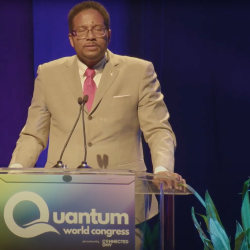Wendell Hill Elected to the American Academy of Arts and Sciences
His election brings the number of faculty in the college who are members of the American Academy of Arts and Sciences to 16
University of Maryland Professor Wendell T. Hill III has been elected to the American Academy of Arts and Sciences, one of the nation’s oldest and most prestigious honorary societies. A professor in the Institute for Physical Science and Technology, Hill is among the 269 new members elected in 2023 for their accomplishments in academia, business, government and public affairs.

“We are proud to see one of our longtime faculty members, Dr. Hill, honored by the American Academy of Arts and Sciences for his trailblazing record of academic accomplishments,” said Amitabh Varshney, dean of UMD’s College of Computer, Mathematical, and Natural Sciences.
Hill joined UMD in 1982 and was promoted to professor in 1996. He is an affiliate professor in the Department of Physics and has been a Fellow in the Joint Quantum Institute since 2006.
“I am very honored to be recognized by the American Academy of Arts and Sciences and humbled to be included in a group of such extraordinary individuals, several of whom are from our campus,” Hill said. “I resonate with the purpose ‘to serve’ and look forward to joining my colleagues in this effort for the common good.”
Hill's research focuses on laser-matter interaction under extreme conditions—ultra-fast, ultra-intense and ultra-cold. His recent work includes ultracold atoms to study fundamental quantum features, attosecond pulses to probe quantum-correlated electron dynamics in atoms and molecules, and super-intense laser pulses to investigate ephemeral particle-antiparticle pairs that reveal the quantum nature of the vacuum.
He has published more than 150 articles, and he has advised and mentored dozens of undergraduate, graduate and postdoctoral students, and junior faculty members.
Hill is a Fellow of the American Physical Society and a member of the National Academies’ Board on Physics and Astronomy and the Scientific Advisory Committee for the Centro de Lasers Pulsados in Spain. He received the National Science Foundation (NSF) Presidential Young Investigator Award (now known as the Presidential Early Career Award for Scientists and Engineers) and the designation of Science Maker by the History Makers. He also served as director of the NSF’s Atomic, Molecular and Optical Program from 2010 to 2012.
Hill earned his bachelor’s degree in physics from the University of California, Irvine in 1974 and his Ph.D. in physics from Stanford University in 1980.
His election brings the number of CMNS faculty who are members of the American Academy of Arts and Sciences to 16.
The American Academy of Arts and Sciences was founded in 1780 by John Adams, John Hancock, and others who believed the new republic should honor exceptionally accomplished individuals and engage them in advancing the public good. According to the Academy, its dual mission remains essentially the same with honorees drawn from increasingly diverse fields and whose work focuses on the arts, democracy, education, global affairs, and science.







